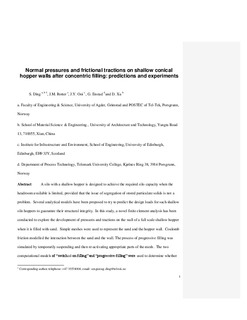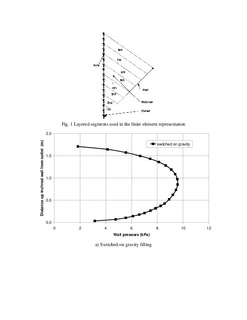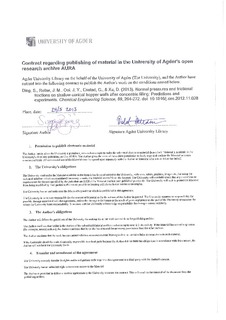| dc.contributor.author | Ding, S. | |
| dc.contributor.author | Rotter, J. M. | |
| dc.contributor.author | Ooi, J. Y. | |
| dc.contributor.author | Enstad, G. | |
| dc.contributor.author | Xu, D. | |
| dc.date.accessioned | 2013-05-21T11:23:23Z | |
| dc.date.available | 2013-05-21T11:23:23Z | |
| dc.date.issued | 2013 | |
| dc.identifier.citation | Ding, S., Rotter, J. M., Ooi, J. Y., Enstad, G., & Xu, D. (2013). Normal pressures and frictional tractions on shallow conical hopper walls after concentric filling: Predictions and experiments. Chemical Engineering Science, 89, 264-272. doi: 10.1016/j.ces.2012.11.028 | no_NO |
| dc.identifier.issn | 0009-2509 | |
| dc.identifier.uri | http://hdl.handle.net/11250/136952 | |
| dc.description | Author's version of an article in the journal: Chemical Engineering Science. Also available from the publisher at: http://dx.doi.org/10.1016/j.ces.2012.11.028 | no_NO |
| dc.description.abstract | A silo with a shallow hopper is designed to achieve the required silo capacity when the headroom available is limited, provided that the issue of segregation of stored particulate solids is not a problem. Several analytical models have been proposed to try to predict the design loads for such shallow silo hoppers to guarantee their structural integrity. In this study, a novel finite element analysis has been conducted to explore the development of pressures and tractions on the wall of a full scale shallow hopper when it is filled with sand. Simple meshes were used to represent the sand and the hopper wall. Coulomb friction modelled the interaction between the sand and the wall. The process of progressive filling was simulated by temporarily suspending and then re-activating appropriate parts of the mesh. The two computational models of "switched-on filling" and "progressive-filling" were used to determine whether this simple treatment of the deposition process makes a significant difference to the predicted forces on the hopper wall: it is evident that progressive filling produces some significant changes that lead to more realism. Experiments were also conducted that measured local pressures on the shallow hopper wall under axisymmetric filling with sand. Comparisons between the numerical predictions, the measurements and existing algebraic models are presented. The results show clearly that wall friction is not fully developed in a shallow hopper, and that one algebraic model captures the behaviour well. However, the results also show that this problem is quite complicated and worthy of further study. | no_NO |
| dc.language.iso | eng | no_NO |
| dc.publisher | Elsevier | no_NO |
| dc.subject | particulate solids | no_NO |
| dc.subject | hopper pressures | no_NO |
| dc.subject | shallow hopper | no_NO |
| dc.subject | FEM simulation | no_NO |
| dc.subject | silo loads | no_NO |
| dc.subject | experimental verification | no_NO |
| dc.title | Normal pressures and frictional tractions on shallow conical hopper walls after concentric filling: Predictions and experiments | no_NO |
| dc.type | Journal article | no_NO |
| dc.type | Peer reviewed | no_NO |
| dc.subject.nsi | VDP::Mathematics and natural science: 400::Mathematics: 410 | no_NO |
| dc.subject.nsi | VDP::Technology: 500::Building technology: 530 | no_NO |
| dc.source.pagenumber | 264-272 | no_NO |
| dc.source.volume | 89 | no_NO |
| dc.source.journal | Chemical Engineering Science | no_NO |
| dc.identifier.doi | 10.1016/j.ces.2012.11.028 | |


